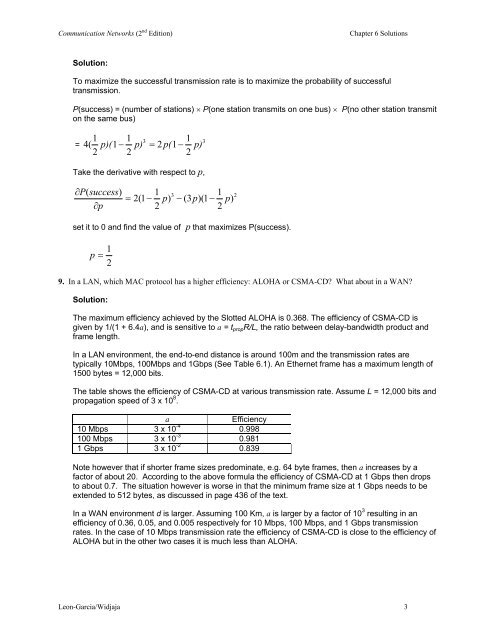Solutions to Chapter 6 - Communication Networks
Solutions to Chapter 6 - Communication Networks
Solutions to Chapter 6 - Communication Networks
Create successful ePaper yourself
Turn your PDF publications into a flip-book with our unique Google optimized e-Paper software.
<strong>Communication</strong> <strong>Networks</strong> (2 nd Edition)<br />
<strong>Chapter</strong> 6 <strong>Solutions</strong><br />
Solution:<br />
To maximize the successful transmission rate is <strong>to</strong> maximize the probability of successful<br />
transmission.<br />
P(success) = (number of stations) × P(one station transmits on one bus) × P(no other station transmit<br />
on the same bus)<br />
=<br />
1<br />
2<br />
1<br />
2<br />
1<br />
2<br />
3<br />
3<br />
4(<br />
p)( 1−<br />
p) = 2 p( 1−<br />
p)<br />
Take the derivative with respect <strong>to</strong> p,<br />
∂P(<br />
success)<br />
∂p<br />
= 2(1 −<br />
1<br />
p)<br />
2<br />
3<br />
1 2<br />
− (3p)(1<br />
− p)<br />
2<br />
set it <strong>to</strong> 0 and find the value of p that maximizes P(success).<br />
1<br />
p =<br />
2<br />
9. In a LAN, which MAC pro<strong>to</strong>col has a higher efficiency: ALOHA or CSMA-CD What about in a WAN<br />
Solution:<br />
The maximum efficiency achieved by the Slotted ALOHA is 0.368. The efficiency of CSMA-CD is<br />
given by 1/(1 + 6.4a), and is sensitive <strong>to</strong> a = t prop R/L, the ratio between delay-bandwidth product and<br />
frame length.<br />
In a LAN environment, the end-<strong>to</strong>-end distance is around 100m and the transmission rates are<br />
typically 10Mbps, 100Mbps and 1Gbps (See Table 6.1). An Ethernet frame has a maximum length of<br />
1500 bytes = 12,000 bits.<br />
The table shows the efficiency of CSMA-CD at various transmission rate. Assume L = 12,000 bits and<br />
propagation speed of 3 x 10 8 .<br />
a<br />
Efficiency<br />
10 Mbps 3 x 10 -4 0.998<br />
100 Mbps 3 x 10 -3 0.981<br />
1 Gbps 3 x 10 -2 0.839<br />
Note however that if shorter frame sizes predominate, e.g. 64 byte frames, then a increases by a<br />
fac<strong>to</strong>r of about 20. According <strong>to</strong> the above formula the efficiency of CSMA-CD at 1 Gbps then drops<br />
<strong>to</strong> about 0.7. The situation however is worse in that the minimum frame size at 1 Gbps needs <strong>to</strong> be<br />
extended <strong>to</strong> 512 bytes, as discussed in page 436 of the text.<br />
In a WAN environment d is larger. Assuming 100 Km, a is larger by a fac<strong>to</strong>r of 10 3 resulting in an<br />
efficiency of 0.36, 0.05, and 0.005 respectively for 10 Mbps, 100 Mbps, and 1 Gbps transmission<br />
rates. In the case of 10 Mbps transmission rate the efficiency of CSMA-CD is close <strong>to</strong> the efficiency of<br />
ALOHA but in the other two cases it is much less than ALOHA.<br />
Leon-Garcia/Widjaja 3







